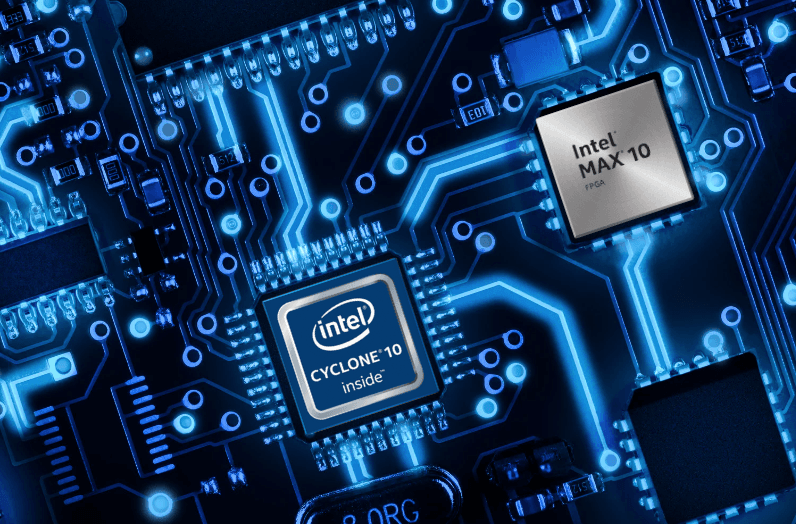Comparing FPGAs: Intel Cyclone 10 vs Intel Max 10

More from the Category
Field Programmable Gate Arrays (FPGAs) have become integral components in various industries because they enable customization and flexibility in hardware design.
Learn More: FPGAs
Intel, a top FPGA manufacturer, offers several FPGA families, including the Intel Cyclone 10 and Intel Max 10. In this article, we’ll explore the functionality, performance, and benefits of these two FPGA families.
Intel Cyclone 10 FPGAs
The Intel Cyclone 10 FPGA family has 2 branches, the GX series and the LP series, each of which is suited for different applications.
Intel Cyclone 10 GX FPGA
Intel Cyclone 10 GX FPGAs are designed for high-performance applications that require advanced features and robust processing capabilities. With support for configurations of up to 220K logic elements, the Cyclone 10 GX series is particularly well-suited for complex applications where computational power is critical.
These FPGAs boast enhanced digital signal processing (DSP) blocks, making them ideal for tasks such as audio and video processing. Furthermore, the Cyclone 10 GX supports high-speed memory interfaces, with 12.5 Gbps chip-to-chip transceiver I/O and 6.6 Gbps backplane support, enabling efficient data handling in environments that require rapid access to large datasets.
Intel Cyclone 10 LP FPGA
In contrast, the Intel Cyclone 10 LP FPGA family is optimized for low-power applications where energy efficiency is a primary concern. This family is designed for a broad spectrum of applications, but is particularly appealing for use in consumer electronics, industrial control, and automotive systems.
The Cyclone 10 LP is engineered to minimize both static and dynamic power consumption, making it an excellent choice for battery-operated devices. Despite having lower logic density than the GX series, with configurations up to 120K logic elements, its scalable architecture allows for versatile designs and integration with various communication protocols.
Learn More: Intel Cyclone
Intel Max 10 FPGAs
The Intel Max 10 FPGA family focuses on delivering high performance with integrated features at low power, catering specifically to embedded applications. One of its standout features is non-volatile memory, which ensures that configuration settings are retained even when power is lost. This characteristic is essential for systems requiring immediate functionality upon startup. Additionally, the Max 10 incorporates analog-to-digital converters (ADCs) for real-time data processing, making it suitable for interfacing with sensors. Designed with a compact form factor, the Max 10 is ideal for applications with space constraints.
Learn More: Max 10 FPGA
Comparative Analysis
Functionality
When comparing the functionality of these FPGAs, each family shines in different areas. The Cyclone 10 GX is optimized for high-performance tasks such as video processing and advanced signal processing. The Cyclone 10 LP, on the other hand, is focused on high-volume, cost-sensitive functions and is better suited for embedded and motor control systems and chip-to-chip interfacing. The Max 10 combines speed with various I/O standards and analog capabilities, making it ideal for power-constrained embedded systems that require immediate responsiveness to real-time data.
Performance
Performance varies across the three families. The Cyclone 10 GX, with its higher logic density and enhanced DSP capabilities, supports complex algorithms and demanding applications, achieving impressive throughput and efficiency. While the Cyclone 10 LP has lower logic density, its power-efficient design allows it to deliver adequate performance for less demanding tasks without sacrificing battery life. The Max 10 offers strong performance in low power applications, particularly where non-volatile memory and fast processing are needed, but it may not match the Cyclone 10 GX in computational power.
Use Cases
The intended applications for each FPGA family differ significantly. The Intel Cyclone 10 GX is perfect for high-performance applications like machine vision, video processing, and medical imaging systems. Cyclone GX FPGAs are often used in environments that demand heavy lifting in terms of data handling and processing. The Intel Cyclone 10 LP is best suited for consumer electronics, IoT devices, and industrial automation, where its cost and energy-efficient design makes it an excellent choice for applications requiring low power yet reliable performance. The Intel Max 10 is commonly used in data acquisition, sensor interfacing, and automotive systems, where immediate responsiveness is critical.
Recent Developments
Intel has been actively enhancing both the Cyclone 10 and Max 10 FPGA families, with recent advancements including:
Enhanced Tool Support: Intel has improved its FPGA design tools, such as Quartus Prime, to facilitate more streamlined design processes. This includes better integration of software and hardware tools, enabling faster prototyping and deployment.
Market Adoption: Both FPGA families have seen increased adoption in emerging markets like IoT and AI, where flexibility and performance are paramount. Companies are increasingly turning to these FPGAs to meet the demands of smart devices and edge computing applications.
Collaboration with Ecosystem Partners: Intel has been working with various ecosystem partners to ensure that both Cyclone 10 and Max 10 FPGAs can easily integrate with a wide array of sensors, protocols, and other components. This has broadened the application range and facilitated quicker time-to-market for developers.
Intel Cyclone 10 vs Intel Max 10
When selecting between the Intel Cyclone 10 and Intel Max 10 FPGA families, it’s essential to consider the specific demands of your application in terms of power, performance, and feature integration.
Intel Cyclone 10
The Cyclone 10 family is optimized for low-power, cost-sensitive applications where mid-range performance is a priority. It features a range of configurable logic blocks (CLBs) and offers a balance of performance and power efficiency, making it ideal for industrial automation, automotive infotainment, and IoT applications. Cyclone 10 GX devices also support high-speed serial transceivers, enabling them to deliver higher throughput, which is critical for data-intensive tasks.
Key Technical Features:
Process Technology: 20nm low-power process
Max Logic Elements: Up to 220K LEs (Logic Elements)
Memory Interface: DDR3 and DDR4 support up to 1600 Mbps
DSP Blocks: Up to 396 dedicated DSP blocks for high-performance digital signal processing
Transceivers: Up to 12.5 Gbps for Cyclone 10 GX variants
Intel Max 10:
The Max 10 FPGA family integrates non-volatile memory (NVM) and analog functionality directly onto the FPGA fabric, which is unique in its class. This integration eliminates the need for external configuration memory, reducing board space and system complexity. Its advanced non-volatile technology allows for instant-on functionality, making it particularly suited for industrial, automotive, and control system applications that require high reliability and fast startup times. Additionally, Max 10 FPGAs include built-in analog-to-digital converters (ADCs), simplifying the design process for mixed-signal applications.
Key Technical Features:
Process Technology: 55nm embedded flash technology
Max Logic Elements: Up to 50K LEs
Non-volatile Configuration: Instant-on with integrated flash memory
Analog Integration: 18-bit ADCs for integrated analog signal processing
Power: Low power consumption with multiple power-saving modes
Both FPGA families are widely applicable across sectors like automotive, consumer electronics, and industrial automation. The recent enhancements to these product lines further strengthen their utility for modern embedded systems and high-reliability designs.
Partner with Us
Choosing between Cyclone 10 and MAX 10 depends on your design’s performance, memory, and integration requirements. Evaluating these factors will help ensure you select the FPGA that best supports your application and development goals.
Partner with Microchip USA to source the right FPGA or any electronic component your project requires. Our team provides reliable supply, competitive pricing, and expert support for hard-to-find and obsolete parts - helping you move designs forward and bring solutions to market faster. Contact us today or explore our FPGA inventory.









